Famous Paintings of Love
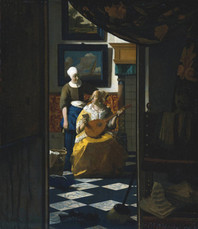
Johannes Vermeer's "Love Letter"
By Lisa Porter, eHow Contributor
Dutch genre paintings of the 17th and 18th century often focused on formal courtship scenes, and 18th-century French rococo painters made the courtship theme more overt. Recently, contemporary painters have shocked audiences with sexually explicit, porn-inspired paintings. The satire that painters have hinted at for centuries has also become more explicit in some contemporary artists' work dealing with love, sex, and couples.
Johannes Vermeer's "Love Letter" (1669-1670) gives the viewer a glimpse through a dark room to another room beyond, where a woman has paused her music playing to receive a letter from her maid. The woman's questioning expression endows this simple moment with significance. The painting's perspective from another room gives the viewer the slightly voyeuristic feeling that she is witnessing a private, intimate moment. The painting's small dimensions reinforce its sense of intimacy.
Dutch genre paintings of the 17th and 18th century often focused on formal courtship scenes, and 18th-century French rococo painters made the courtship theme more overt. Recently, contemporary painters have shocked audiences with sexually explicit, porn-inspired paintings. The satire that painters have hinted at for centuries has also become more explicit in some contemporary artists' work dealing with love, sex, and couples.
Johannes Vermeer's "Love Letter" (1669-1670) gives the viewer a glimpse through a dark room to another room beyond, where a woman has paused her music playing to receive a letter from her maid. The woman's questioning expression endows this simple moment with significance. The painting's perspective from another room gives the viewer the slightly voyeuristic feeling that she is witnessing a private, intimate moment. The painting's small dimensions reinforce its sense of intimacy.
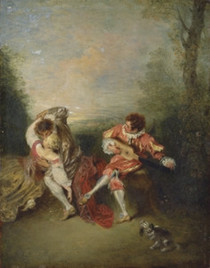
Jean-Antoine Watteau's "La Surprise"
French painter Jean-Antoine Watteau (1684-1721) painted scenes of balls, courtship, and domestic life. His romantic scenes convey a sense of the often sudden, fleeting, transient, or surprising nature of love. In the painting "La Surprise," for example, a couple embraces passionately while a musician plays only feet away. This particular painting resurfaced in a British country home in 2008, surprising art historians who had long since assumed it was lost or destroyed. The painting is small and intimately scaled at only about a foot high.
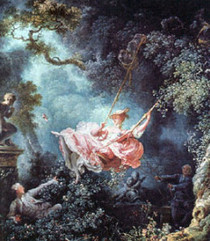
Jean-Honore Fragonard's "The Swing"
Rococo painter Fragonard (1732-1806) is known for his scenes of love and frivolity. In "The Swing" (1767), a young man hides in the bushes to watch as his lover swings above him, revealing the undergarments beneath her skirt. In "The Stolen Kiss" (1756-61), a young couple is poised to embrace while another woman looks on, in a composition similar to Watteau's "La Surprise." Another Fragonard painting also called "The Stolen Kiss" shows a young man kissing his lover in a dark room, with a party in view through the door. Pastel colors and flowing silks invariably fill Fragonard's images.
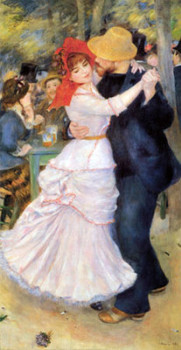
Pierre-Auguste Renoir's "Dance at Bougival"
French painter Pierre-Auguste Renoir (1841-1919) painted scenes of daily life. Renoir was deeply influenced by his close friend Claude Monet, and the two painters often worked on paintings of the same subjects. Renoir's paintings are known for their bright color and cheerful sensibility. His "Dance at Bougival" (1882-1883) exemplifies these elements. The painting shows a young couple dancing outdoors, bathed in dappled light.
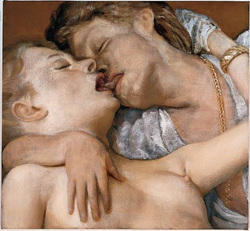
John Currin's "Kissers"
John Currin often causes controversy and outrage with his exaggerated, almost grotesque nude portraits, mostly of women. Currin draws on both porn and old master paintings for inspiration, and this combination can be jarring to viewers. His erotic images mark a complete departure from the light courtship scenes of Fragonard. His 2006 painting "Kissers" shows a young couple kissing with eyes closed and tongues in each other's mouths; the man's hand falls onto the woman's breast. Other Currin paintings are far more explicit than this; "The Danes" (2006), "Rotterdam" (2006), and "Trouville" (2007) have shocked viewers in high-profile New York galleries.
